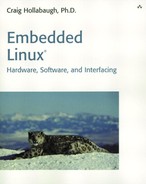The Project Trailblazer Asynchronous Serial Hardware Development Environment
The Project Trailblazer serial development environment consists of the development workstation, tbdev1, target platform and the peripheral devices: RFID tag reader, LCD display, and lift access permission signal. Figure 6.1 shows the various electrical connections and signal flows. ESPTech of Lakewood, Colorado, supplies the RFID tag reader. Scott Edwards Electronics supplies the serial LCD display. The access permission circuitry driven by an RS-232 signal illuminates a red light or green light.
Figure 6.1. The Project Trailblazer asynchronous serial hardware development environment.

Target EIA/TIA-232-E Compliance
When you have Linux booted on all platforms, you should be able to develop software for any platform and then port it to another platform by merely cross-compiling. Ideally, the Project Trailblazer engineers could develop and test all the serial communications code on tbdev1 and then cross-compile it for the PowerPC and ARM platforms. Unfortunately, the RPX-CLLF and MediaEngine hardware design does not allow for control of the serial port signal lines.2,3 The manufacturers state that there is no hardware flow control support on the serial ports. This means that hardware designs can't access the Request to Send (RTS), Data Terminal Ready (DTR), Clear to Send (CTS), Data Set Ready (DSR), and Ring (RI) control signals. These target boards support asynchronous serial communication but don't fully comply with the current EIA/TIA-232-E standard. The Access Permission circuit in Figure 6.1 requires connection to the DTR control signal. Therefore, the RPX-CLLF and MediaEngine can't be used in this hardware design. You will use the x86 target platforms to develop and test the setSerialSignal, getSerialSignal and querySerial programs.
